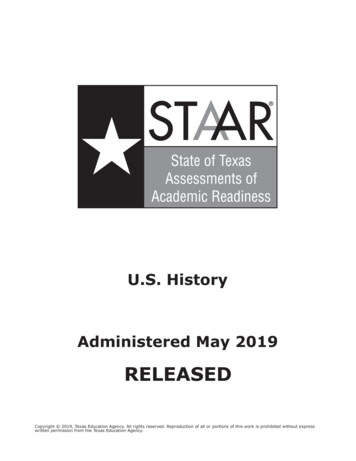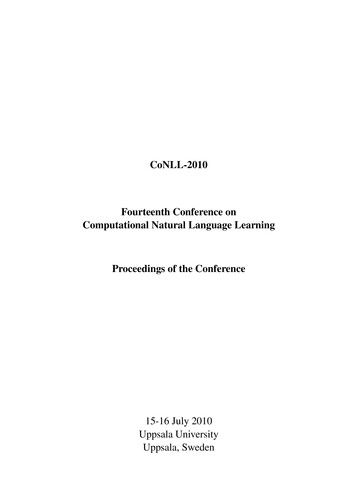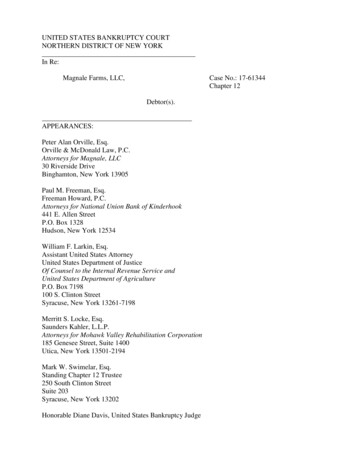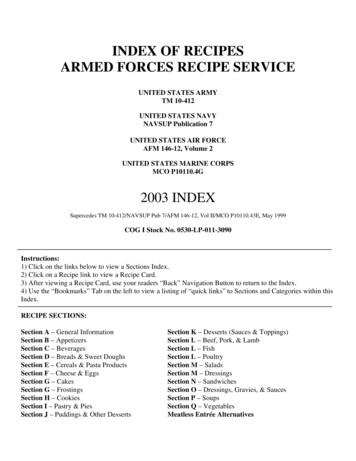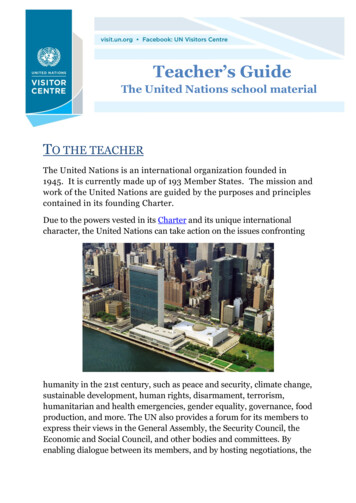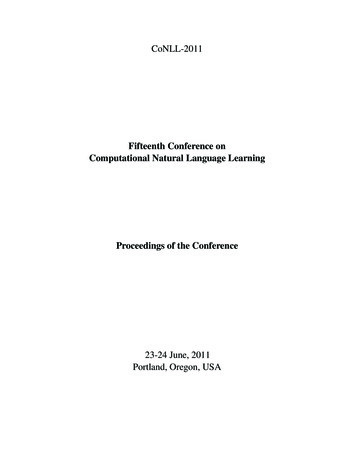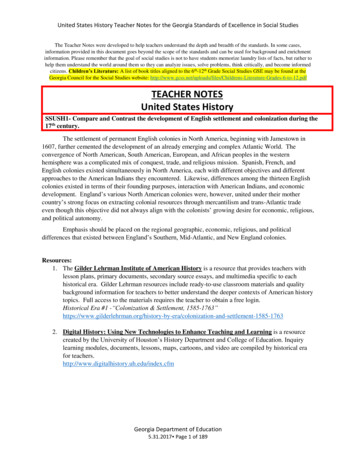
Transcription
United States History Teacher Notes for the Georgia Standards of Excellence in Social StudiesThe Teacher Notes were developed to help teachers understand the depth and breadth of the standards. In some cases,information provided in this document goes beyond the scope of the standards and can be used for background and enrichmentinformation. Please remember that the goal of social studies is not to have students memorize laundry lists of facts, but rather tohelp them understand the world around them so they can analyze issues, solve problems, think critically, and become informedcitizens. Children’s Literature: A list of book titles aligned to the 6th-12th Grade Social Studies GSE may be found at theGeorgia Council for the Social Studies website: ture-Grades-6-to-12.pdfTEACHER NOTESUnited States HistorySSUSH1- Compare and Contrast the development of English settlement and colonization during the17th century.The settlement of permanent English colonies in North America, beginning with Jamestown in1607, further cemented the development of an already emerging and complex Atlantic World. Theconvergence of North American, South American, European, and African peoples in the westernhemisphere was a complicated mix of conquest, trade, and religious mission. Spanish, French, andEnglish colonies existed simultaneously in North America, each with different objectives and differentapproaches to the American Indians they encountered. Likewise, differences among the thirteen Englishcolonies existed in terms of their founding purposes, interaction with American Indians, and economicdevelopment. England’s various North American colonies were, however, united under their mothercountry’s strong focus on extracting colonial resources through mercantilism and trans-Atlantic tradeeven though this objective did not always align with the colonists’ growing desire for economic, religious,and political autonomy.Emphasis should be placed on the regional geographic, economic, religious, and politicaldifferences that existed between England’s Southern, Mid-Atlantic, and New England colonies.Resources:1. The Gilder Lehrman Institute of American History is a resource that provides teachers withlesson plans, primary documents, secondary source essays, and multimedia specific to eachhistorical era. Gilder Lehrman resources include ready-to-use classroom materials and qualitybackground information for teachers to better understand the deeper contexts of American historytopics. Full access to the materials requires the teacher to obtain a free login.Historical Era #1 -“Colonization & Settlement, by-era/colonization-and-settlement-1585-17632. Digital History: Using New Technologies to Enhance Teaching and Learning is a resourcecreated by the University of Houston’s History Department and College of Education. Inquirylearning modules, documents, lessons, maps, cartoons, and video are compiled by historical erafor mGeorgia Department of Education5.31.2017 Page 1 of 189
United States History Teacher Notes for the Georgia Standards of Excellence in Social StudiesSSUSH1 – Compare and Contrast the development of English settlement and colonization during the17th century.a. Investigate how mercantilism and trans-Atlantic trade led to the development of colonies.Although many English colonists came to North America searching for religious or politicalopportunity, it was economic opportunity that fueled the ambition of other English colonists, as well as,their mother country. Investors sought financial returns for their colonial ventures. England sought toextract resources from North America in order to compete with their European rivals for wealth andpower. By the 1650s, England was heavily entrenched in trans-Atlantic trade based on mercantilism.Mercantilism is an economic theory based on reducing a country’s imports while expanding itsexports in order to maximize wealth. In the highly competitive European world of the sixteenth andseventeenth centuries, wealth equated to power. Thus, mercantilism inspired European governments,including England, to promote American colonies as sources of raw materials not readily available in themother country. Some of the most important resources England plucked from its colonies includedlumber, sugar, wool, tobacco, rice, and indigo. These raw materials were then used in England toproduce manufactured goods for export to other European countries and back to the colonists in NorthAmerica.A favorable tradebalance resultedfor England in thecolonialarrangement. Rawmaterials that werescarce in Englandwere acquired fromtheir colonialpossessions.Simultaneously, thecolonies were aready market forthe manufacturedproducts producedin England from theraw materials. Thetrans-Atlantic tradenetwork that resulted led to various colonial labor arrangements and restrictive policies to ensureEngland maximized its mercantilist potential.England implemented a series of Navigation Acts in the mid-1600s to ensure a favorable tradearrangement with the colonies. The laws were designed to keep England’s own colonies fromcompeting with their mother country by mandating three fundamental criteria for trans-Atlantic trade.First, all goods shipped to or from English North America had to travel on English ships. Second, anygoods being imported to the colonies from Europe had to first be processed through an English port.Georgia Department of Education5.31.2017 Page 2 of 189
United States History Teacher Notes for the Georgia Standards of Excellence in Social StudiesAnd third, most colonial resources could only be exported to England. The Navigation Acts restrictedthe profits colonists could receive for their products, hindered the development of large scalemanufacturing in the colonies, and forced colonists to pay high prices for goods they were only allowedto purchase from England. One positive effect of the Navigation Acts on the colonies was theemergence of ship building as a viable industry in New England. Since the Navigation Acts required allgoods to travel on English ships, there was an instant demand for more ships to be built from the lumberreadily available in North America. Another effect of the Navigation Acts was increased smuggling ofgoods into North America by colonists who sought their own lucrative trade practices- regardless oflegality.A good document to use with students concerning the reasons for England’s interest incolonizing North America is Richard Hakluyt’s 1584essay, Discourse of Western Planting. Excerpts fromthis document have been compiled by the NationalHumanities Center and can be accessed n/exploration/text5/hakluyt.pdf .England’s trans-Atlantic trade flourished under the mercantilist system. Trans-Atlantic trade,sometimes referred to as Triangular Trade, often took a three step voyage around the Atlantic rim.First, English ships loaded with rum, cloth, and other manufactured goods sailed to Africa, where theywere traded for Africans as part of the slave trade. Then, in the Middle Passage (discussed further inSSUSH2), the slaves were transported on a brutal voyage to the Americas and sold there as a forcedlabor commodity to colonial landowners. The third step of the journey transported American rawmaterials to England to be made into theIllustration of Triangular Trade modelmanufactured goods that would start the cycle again.Indenture betweenPatrick Larkin and Thomas Blood,17 August 1766, VirginiaColonial labor was critical for the production ofmaterials England needed for a profitable mercantilistsystem. Labor needs were first filled through the use ofindentured servants and then later by permanentlyenslaved Africans. Indentured servants were typically lowerclass Englishmen who could not afford to pay for the voyageto North America but saw life in the colonies as anopportunity for economic advancement they wouldotherwise never have in England. Indentured servantsworked for a land owner in exchange for their passage toNorth America. The land owner obtained labor and theindentured servant obtained the future opportunity toown land after working off their debt over a period ofapproximately four to seven years.Tensions began to develop over the continual need toGeorgia Department of Education5.31.2017 Page 3 of 189
United States History Teacher Notes for the Georgia Standards of Excellence in Social Studiessupply land to newly freed indentured servants. African slaves were introduced as a labor sourcebeginning in 1619 (discussed in SSUSH2). Eventually, plantation owners came to rely on African slavesas a more profitable and renewable source of labor.England developed resource-producing colonies in North America primarily to fuel mercantilismand to amass wealth and power over their European rivals. The resulting trans-Atlantic trade systemwas regulated through Navigation Acts and led to various labor sources being used by colonists to meetthe resource demands of England.Resources:1. From Raw Materials to Riches: Mercantilism and the British North AmericanColonies is a simulation lesson produced by the Federal Reserve Bank’s EducationalResources division. Students interpret primary sources through simulation in order tobetter evaluate the strengths and weaknesses of the mercantilist policies used by Englandin the SH1 – Compare and Contrast the development of English settlement and colonization during the17th century.b. Explain the development of the Southern Colonies, including but not limited to reasons established, impactof location and place, relations with American Indians, and economic development.The Southern Colonies included Virginia, Maryland, Carolina (which eventually split into NorthCarolina and South Carolina), and Georgia. The location of the Southern Colonies, with the region’s richsoil and long growing season, fostered the development of strong agricultural producing colonies. Deeprivers and the distance of the fall line from the coast meant that inlandfarmers were able to ship tobacco, indigo, corn, and rice directly from theirfarms to European markets. The economic development of the SourthernColonies reflected this geological line. Subsistence family farms tended todevelop north of the fall line. These farms grew primarily what the familyneeded along with a small cash crop used to purchase or barter for goodssuch as salt, gunpowder, lead, and iron tools. Commercial farms tended todevelop south of the fall line and grew primarily high yield, labor intensivecash crops such as rice, tobacco, and indigo. As a result, slave labor was morecommon south of the fall line while less common north of the same line.Fall Line MapRelations with American Indians in the Southern Colonies begansomewhat as a peaceful coexistence. As more English colonists began to arrive and encroach furtherinto native lands, the relationship became more violent. The complexity of the interactions withAmerican Indians in the Southern Colonies grew as the region’s economic development grew. Oncelarge scale cash crops of tobacco, rice, and indigo proved highly profitable in the mercantilist system,more colonists arrived seeking economic opportunity. The growing English population in the SouthernColonies required more of the American Indians’ land for crop cultivation, which fueled increasedtension between the groups.Georgia Department of Education5.31.2017 Page 4 of 189
United States History Teacher Notes for the Georgia Standards of Excellence in Social StudiesTeachers may choose to use thefollowing content concerning thedevelopment of specific SouthernColonies as examples to frame thecomponents of this element forstudents. However, students arenot responsible for the specificinformation that follows.VirginiaThe first permanent Englishcolony in North America wasfounded in 1607 at Jamestown,Virginia. The establishment ofJamestown was a business ventureof London’s Virginia Company, ajoint-stock company, which raised capital for the expedition to America by selling shares of companystock to investors. Once financed by investors, the Virginia Company planned to send colonists to findgold and other valuable natural resources in America. The spoils would be sent back to England to payoff investors and make a handsome profit. The Virginia Company was granted a royal charter by KingJames I in 1606. The full text of the Virginia Charter may be accessed from Yale University’s AvalonProject (http://avalon.law.yale.edu/17th century/va01.asp ). The charter gave the Virginia Companythe authority to govern and settle the North American colony in the name of England. There were 104settlers who arrived to settle Jamestown in 1607.Initially, the colony sufferedAerial View of Jamestown Settlement bymightily. Disease, famine, and IndianNational Park Service Artist Sydney Kingattacks all hindered the Jamestownsettlement from fullfilling the Virginia Company’s vision for the colony. The colony was planted alongthe James River, which bred deadly diseases such as malaria and dysentary. A lack of leadership alsocaused the colonists to be unprepared to sustain themselves through the first winter. Food and shelterhad not been the priority for the wealth seeking early colonists to Jamestown.Captain John Smith eventually took forceful control of the colony, mandating much neededdiscipline to the remaining colonists. His famous order, “He that will not work will not eat,” encouragedmore farming and the construction of a better fortification. Smith was not always popular among thesettlers, but his brand of leadership helped save the fledgeling settlement. Primary documents fromCaptain Smith’s voyage and leadership in Jamestown can be accessed through the Library of Congress’sClassroom Materials Collection, “The English Establish a Foothold at Jamestown, /timeline/colonial/jamestwn/ ).Tobacco production was another development that helped to save the Jamestown colony andmake it more lucrative. John Rolfe, who later married the American Indian princess Pocahontas,arrived in Jamestown in 1610 from the Caribbean. He experimented with tobacco seeds to produce acrop that became very desirable in Europe. Having survived the starving time of Jamestown’s earlyGeorgia Department of Education5.31.2017 Page 5 of 189
United States History Teacher Notes for the Georgia Standards of Excellence in Social Studiesyears and secured the financial importance of the colony with tobacco production, Virginia emerged as acritical component of England’s mercantilist system.The relationship between English settlers at Jamestown and the area’s American Indians wascomplex. Chief Powhatan was the principal leader of all the Powhatan tribes in the Chesapeake Bayregion when the English settlers arrived in 1607. Powhatan was wary of the Jamestown colonists butmaintained primarily a peaceful coexistence with the desparate Englishmen duringtheir first few years in North America. The natives provided much needed cornduring the lean winter months and there were only minor skirmishes between thecolliding cultures in Virginia.John Rolfe’s arrival in Jamestown changed many aspects of the colony.Accounts of Rolfe’s marriage to Chief Powhatan’s daughter, Pocahontas, differdramatically between the English version of a concentual marriage and theAmerican Indian version of the story that depicts a kidnapping and forcedmarriage. Regardless of the circumstances of the marriage, the relationshipbetween the Englishmen and Virginia’s American Indians declined rapidly as moresettlers arrived to seek fortune in tobacco cultivation. The increased number ofPocahontassettlers took greater amounts of land from the Powhatans. The death of Chief1624Powhatan, who had remained relatively peaceful with the Englishmen, alsomarked a change in the relationship Jamestown had with the region’s American Indians. Powhatan’sbrother, Opechancanough, came to power in 1618 and subsequently launched large scale attacks on thequickly growing English colony.MarylandIn 1632, King Charles I granted Lord Baltimore proprietary rights to land in the Chesepeake Bayregion to plant a colony. The land was a reward for the noble’s service to the king. The resulting colonyof Maryland was settled initially as a haven for Catholics who were being persecuted by Protestants.Because the Chesapeake Bay region was fertile ground for tobacco production, similar to land inneighboring Virginia, Maryland’s Catholics were quickly outnumbered in their own colony. In an effortto preserve the rights of Catholics in Maryland, the Lord Baltimore quickly had the Act of Tolerationpassed in the Maryland legislative assembly. This colonial law guaranteed religious freedom inMaryland to all Christians – Protestant and Catholic. Maryland’s 1649 Act of Toleration can be accessedthrough Yale University’s Avalon Project(http://avalon.law.yale.edu/18th century/maryland toleration.asp)As was true in Virginia, Maryland became a lucrative colony for tobacco production even thoughits initial purpose was religious in nature. The colony’s location, which was conducive to agriculture, wasmore influential in its development than the plans of the proprietor.Carolina (North and South)The Carolina colony was originally a single proprietary colony located between Virginia andSpanish Florida. The land was given in 1663 to eight nobles who had helped Charles II reclaim themonarchy from Oliver Cromwell in what is known as the Restoration. The eight nobles who were givenCarolina were referred to as the Lord Proprietors of the vast colony.Georgia Department of Education5.31.2017 Page 6 of 189
United States History Teacher Notes for the Georgia Standards of Excellence in Social StudiesLocation impacted the development of the Carolinacolony as it had the other Southern Colonies of Virginia andMaryland. Southern Carolina along the coast became a greatproducer of rice and indigo on large commercial plantations. Thecity of Charleston in the southern Carolina colony was atransportation hub for exporting the valuable cash crops.Northern Carolina, above the fall line, had a different soil andclimate, which did not lend itself as readily to rice and indigocultivation. Instead, the farmers in the northern region of thecolony developed small tobacco farms. The Carolina Colony wasofficially divided in 1712 after the wide ranging single colonyChanges to theproved too difficult to manage. South Carolina, with its valuableCarolina ColonyCharleston based resources, was then taken from the proprietorsby the king and made a royal colony in 1719. Later, in 1729, theproprietors sold their shares of North Carolina to the Crown making it too a royal colony.GeorgiaGeorgia was the last English colony established in North America prior to the Revolutionary War.In 1732, Georgia was created by England for two purposes. First, and foremost, England wanted tocreate a defensive buffer between the dangerous Spaniards in Florida and the increasingly valuableSouth Carolina plantations and Charleston port. The second purpose was to reduce the number ofdebtors crowding London jails by sending many of them to the new Georgia colony for a fresh start andto provide defense of South Carolina.General James Oglethorpe and the twenty trustees who were given the charter for Georgiaregulated the colony and its inhabitants with strict rules. The trustees’ list of rules for Georgia can beaccessed by the Library of Congress’s Classroom Materials website for the Georgia ine/colonial/georgia/rules.htmlLand holdings were limited in size to small farms, slavery was banned, and alcohol prohibited.The trustees believed the strict limits on land holdings would prevent the wide economic stratification ofthe population that had developed in Carolina. After theoriginal wave of settlers established the colony atSavannah under Oglethorpe and the trustees’ strictguidance, greater resistance to the rules developed overtime. The Georgia colonists wanted greater autonomy andlocal legislative participation that settlers of the othertwelve colonies enjoyed. By the 1740s, the trustees hadgiven in to most of the Georgia colonists’ demands.View of Savannah, 1734Georgia Department of Education5.31.2017 Page 7 of 189
United States History Teacher Notes for the Georgia Standards of Excellence in Social StudiesResources:1. Historic Jamestown provides background information on the settlement of the Virginia colonyand the primary individuals involved in the early period. The site also gives updatedarchaeological analysis of the site. http://historicjamestowne.org2. Library of Congress Primary Source Set Jamestown- is a compilation of critical documentsand images from the founding of Jamestown. A teacher’s guide and primary source analysissheets offer teachers valuable background information and suggestions for teaching aboutJamestown. marysourcesets/jamestown/3. Library of Congress Primary Source Set Georgia – is a compilation of critical documentsrelated to James Oglethorpe’s founding of the Georgia colony. The site provides a goodoverview of Georgia’s creation in addition to the primary source meline/colonial/georgia/SSUSH1 – Compare and Contrast the development of English settlement and colonization during the17th century.c. Explain the development of the New England Colonies, including but not limited to reasons established,impact of location and place, relations with American Indians, and economic development.The New England Colonies (Massachusetts, Rhode Island, Connecticut, and New Hampshire)were marked by poor, thin, rocky soils and a relatively short growing season that made farming difficult.However, plentiful forests and proximity to the sea led New Englanders to eventually develop a thrivingship building industry. Fishing, whaling, and commercial trade from harbors such as Boston becameimportant economic engines for the region. New Englanders became the merchants of the colonies andNew England-based ships were the carriers of colonial goods in the trans-Atlantic trade.Whereas England’s Southern Colonies were developed for primarily economic gain, the NewEngland Colonies developed initially as religious outposts by various subjugated groups. In particular,Calvinists in England faced increased persecution for their desire to reform the Anglican Church (alsoknown as the Church of England) and their opposition to the growing power of the English monarchy.These religious dissenters, known as Puritans, disagreed with the Protestant Anglican Church’scontinued use of Catholic rituals and traditions. The Puritans wanted to “purify” their Protestant sect ofits heavily entrenched Catholic features. Although the Puritans came to North America for religiousreasons, they were not religiously tolerant of those who did not fully comply with their views of religion.American Indians were viewed by the Puritans as needing to be saved from their sinful wayssince they were not Christians. In the early years of English colonization, the relationship between theAmerican Indians and the Puritans was based primarily on trade and diplomacy given that theEnglishmen were greatly outnumbered. The Puritans did not openly embrace the American Indians butrelied on them for help in the difficult early years for survival. As the English population increased, sodid the conflict with natives of the area. A series of bloody wars (King Philip’s War and the Pequot Wars)ensued during the colonial period between the Puritans and the American Indians of New England.Georgia Department of Education5.31.2017 Page 8 of 189
United States History Teacher Notes for the Georgia Standards of Excellence in Social StudiesTeachers may choose to use the following content concerning the development of specific New EnglandColonies as examples to frame the components of this element for students. However, students are notresponsible for the specific information that follows.Anglican Church Conflict Leads Purtians to Colonize New EnglandThere were two types of Puritans – seperatist Puritans and non-seperatist Puritans. Theseperatist Puritans, also known as Pilgrims, were no longer interested in simply reforming the AnglicanChurch. Instead, the Pilgrims planned to organize a completely “separate” church without the King’sinfluence- hence the name seperatist Puritans. The non-seperatist Puritans, or simply Puritans, wantedthe Anglican Church to “purify” itself of what they saw as problematic Catholic traditions. They wantedto remain part of the Anglican Church if it could become the truly Protestant faith it claimed to be.Using their influence and wealth, the Puritan leadership was able to acquire a majority share in atrading company. Using the trading company as a front, the Puritans moved the headquarters of theLondon Company of Plymouth to Massachusetts. Afterwards, many Puritans and their familiesimmigrated to the American colonies in order to escape persecution. Thus, the New England Colonieswere established by separatist Pilgrims at Plymouth in 1620 and the non-separatist Puritans atMassachusetts Bay in 1630. Like the Virginia colonists, the New England settlers had similar problemsacclimating to their new environment and suffered substantial losses in the early years. Eventually in1691, Plymouth and Massachusetts Bay colonies were combined into one Massachusetts colony.Plymouth ColonyFamous Painting of theMayflower CompactSigningThe Pilgrims set sail on the Mayflower in 1620, withapproximately 100 passengers, headed for Virginia. After astorm blew them off course, their landing on the NorthAmerican coast was a few hundred miles north of theirintended destination. The group decided to stay in theundeveloped area and create a new colony calledPlymouth. Before disembarking the Mayflower, thePilgrims created and signed the Mayflower Compact. Thedocument is important in the study of the early colonialperiod in that it was a pledge by the colonists to governthemselves through majority rule. This is a good document to use withstudents to analyze who signed the document and why it wasnecessary. http://avalon.law.yale.edu/17th century/mayflower.aspMassachusetts Bay ColonyA group of about 1000 non-separatist Puritans were led by John Winthrop on their voyage toNorth America. They established the Massachusetts Bay colony near present-day Boston. Whilecrossing the Atlantic, Winthrop set the tone for the Puritan colonists in his famous “Model of ChristianCharity” speech, which is often referred to as the “city upon a hill” speech. He challenged Puritans towork as hard as they possibly could to make the new colony thrive since the world would be watching toGeorgia Department of Education5.31.2017 Page 9 of 189
United States History Teacher Notes for the Georgia Standards of Excellence in Social Studiessee if they were successful. Essentially, their ability to prosper as a colony through hard work wouldprove their devotion to God and be a symbol to the world. Any person who was not completelycommitted to the overall success of the colony would not be allowed to remain.Strict Puritan rules and an essential work ethic resulted from Winthrop’s pivotal speech to thecolonists. Excerpts from this speech are also effective in helping students understand why the Puritanswere so regimented in their governing of Massachusetts Bay. This link to the Ashbrook Center atAshland University provides a good summary of Winthrop’s “Model of Christian Charity” speech alongwith the full document text t/a-model-ofchristian-charity/The Puritans tightly controlled the political and social structure of the community. Communitieswere run using town meetings. Voting rights were limited to men who belonged to the church, andchurch membership was tightly controlled by each minister and congregation. Towns were run as directdemocracies with each voting member having a direct role in the administration of government. Thechurch was the central force in governing the community. As a result of their strict religious beliefs, thePuritans were not tolerant of religions that differed from their own. Frequently, those who disagreedwith Puritan ideology and practices were banished from the colony (see Rhode Island below).In England, the monarchy was restored to power in 1660. The Crown decided to assert controlover semi-independent Massachusetts. In 1686, King Charles II canceled the Massachusetts Charter. Toget more control over trade with the colonies, James II (who followed Charles II as King of England)combined colonies throughout New England into a single territory, the Dominion of New England.James appointed his own governor, Sir Edmund Amdros, to be the administrator of the Dominion andgovern it as a royal colony. The colonists greatly disliked this centralized authority and overthrew theroyal governor. Events in England led to the dissolution of the Dominion of New England, butMassachusetts remained a royal colony.Political turmoil may have been a factor inone of the most notorious incidents in colonialAmerican history. In 1692, the Salem Witch Trialstook place. The incident began when three girls,ill with symptoms including convulsions and “fits,”accused several local residents of using witchcraftto cause the illness. The hysteria spread and ledto over 150 Massachusetts colonists beingaccused of witchcraft. Of the 150 accused
United States History Teacher Notes for the Georgia Standards of Excellence in Social Studies Georgia Department of Education 5.31.2017 Page 2 of 189 SSUSH1 – Compare and Contrast the development of Englis




